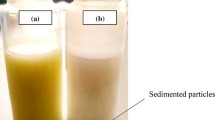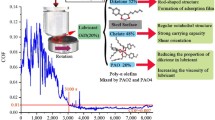Abstract
To improve fuel efficiency and minimize environmental pollution, the interest in organic friction modifiers has resurged, especially fatty acids. Efforts have been made to enhance fatty acids’ performance by tuning their saturation state and adding OH lateral groups in the alkyl chain. Here, we compared lubrication properties in the boundary regime for oleic acid (OA), ricinoleic acid (RA), and linoleic acid (LA) under the same viscosity for a steel/Si3N4 tribo-pair. The presence of the OH group in the OA chain reduces not only friction coefficient (CoF) by ~ 70% but also prevents scratches from generating on both surfaces. In the meantime, it determines local friction distribution by controlling top surface terminations. Even at 100 °C, the steady-state friction coefficient of steel/Si3N4 lubricated by RA is only 0.014. A temperature decrease to 80 °C leads to a superlubricity regime (CoF < 0.01) resulting from the cooperation of nanometer-thick liquid film (possibly containing water) and low friction of contact asperities terminated by OH hydroxyl groups provided by RA. In summary, steel/Si3N4 contact lubricated by ricinoleic acid gives unsurpassed tribological performances reaching superlubricity under a wide range of operating conditions.







Similar content being viewed by others
References
Spikes, H.: Friction modifier additives. Tribol. Lett. 60, 1–26 (2015). https://doi.org/10.1007/s11249-015-0589-z
Ewen, J.P., Gattinoni, C., Morgan, N., Spikes, H.A., Dini, D.: Nonequilibrium molecular dynamics simulations of organic friction modifiers adsorbed on iron oxide surfaces. Langmuir 32, 4450–4463 (2016). https://doi.org/10.1021/acs.langmuir.6b00586
Loehlé, S., Matta, C., Minfray, C., Le Mogne, T., Iovine, R., Obara, Y., Miyamoto, A., Martin, J.M.: Mixed lubrication of steel by C18 fatty acids revisited. Part II: influence of some key parameters. Tribol. Int. 94, 207–216 (2016). https://doi.org/10.1016/j.triboint.2015.08.036
Jahanmir, S., Beltzer, M.: Effect of additive molecular structure on friction coefficient and adsorption. J. Tribol. 108, 109–116 (1986). https://doi.org/10.1115/1.3261129
Tadokoro, C., Araya, S., Okubo, H., Nakano, K., Sasaki, S.: Polarization observations of adsorption behavior of fatty acids using optical anisotropy of liquid crystal. Tribol. Lett. 64, 1–9 (2016). https://doi.org/10.1007/s11249-016-0765-9
Salmeron, M.: Generation of defects in model lubricant monolayers and their contribution to energy dissipation in friction. Tribol. Lett. 10, 69–79 (2001). https://doi.org/10.1023/A:1009026312732
Lundgren, S.M., Persson, K., Mueller, G., Kronberg, B., Clarke, J., Chtaib, M., Claesson, P.M.: Unsaturated fatty acids in alkane solution: adsorption to steel surfaces. Langmuir 23, 10598–10602 (2007). https://doi.org/10.1021/la700909v
Hibi, Y., Nakano, M.: Effect of oleic acid on friction and wear behavior of silicon nitride in ethanol and in n-Undecane. J. Jpn. Soc. Tribologis. 59, 515–520 (2014). https://doi.org/10.14886/sssj2008.33.0_219
Studt, P.: Boundary lubrication: adsorption of oil additives on steel and ceramic surfaces and its influence on friction and wear. Tribol. Int. 22, 111–119 (1989). https://doi.org/10.1016/0301-679X(89)90171-0
Salem, L.: Attractive forces between long saturated chains at short distances. J. Chem. Phys. 37, 2100–2113 (1962). https://doi.org/10.1063/1.1733431
Martin, J.M., Matta, C., Bouchet, M.I.D.B., Forest, C., Le Mogne, T., Dubois, T., Mazarin, M.: Mechanism of friction reduction of unsaturated fatty acids as additives in diesel fuels. Friction 1, 252–258 (2013). https://doi.org/10.1007/s40544-013-0022-2
Kuwahara, T., Romero, P.A., Makowski, S., Weihnacht, V., Moras, G., Moseler, M.: Mechano-chemical decomposition of organic friction modifiers with multiple reactive centres induces superlubricity of ta-C. Nat. Commun. 10, 1–11 (2019). https://doi.org/10.1038/s41467-018-08042-8
Long, Y., Galipaud, J., Weihnacht, V., Makowski, S., Martin, J.M., Bouchet, M.I.D.B.: Achieving superlubricity using selected tribo-pairs lubricated by castor oil and unsaturated fatty acids. Tribo. Int. 169, 107462 (2022). https://doi.org/10.1016/j.triboint.2022.107462
Long, Y., Wang, Y., Weihnacht, V., Makowski, S., Kubo, M., Martin, J.M., Bouchet, M.I.D.B.: Mechanism of superlubricity of a DLC/Si3N4 contact in the presence of castor oil and other green lubricants. Friction (2022). https://doi.org/10.1007/s40544-022-0601-1
Salinas Ruiz, V.R., Kuwahara, T., Galipaud, J., Masenelli-Varlot, K., Hassine, M.B., Héau, C., Stoll, M., Mayrhofer, L., Moras, G., Martin, J.M., Moseler, M., Bouchet, M.I.D.B.: Interplay of mechanics and chemistry governs wear of diamond-like carbon coatings interacting with ZDDP-additivated lubricants. Nat. Commun. 12, 1–15 (2021). https://doi.org/10.1038/s41467-021-24766-6
Hadnadjev, M., Vulic, T., Marinkovic-Neducin, R., Suchorski, Y., Weiss, H.: The iron oxidation state in Mg–Al–Fe mixed oxides derived from layered double hydroxides: an XPS study. Appl. Surf. Sci. 254, 4297–4302 (2008). https://doi.org/10.1016/j.apsusc.2008.01.063
André, E., Vernier, C.: Some physical properties of pure ricinoleic acid: the refractive index, specific gravity, and viscosity. J. Rheol. 3, 336–340 (1932). https://doi.org/10.1122/1.2116497
Rabelo, J., Batista, E., Cavaleri, F.V.W., Meirelles, A.J.: Viscosity prediction for fatty systems. J. Am. Oil Chem. Soc. 77, 1255–1262 (2000). https://doi.org/10.1007/s11746-000-0197-z
Bersani, D., Lottici, P.P., Montenero, A.: Micro-Raman investigation of iron oxide films and powders produced by sol-gel syntheses. J. Raman Spectrosc. 30, 355–360 (1999). https://doi.org/10.1002/(SICI)1097-4555(199905)30:5%3c355::AID-JRS398%3e3.0.CO;2-C
Shebanova, O.N., Lazor, P.: Raman study of magnetite (Fe3O4): laser-induced thermal effects and oxidation. J. Raman Spectrosc. 34, 845–852 (2003). https://doi.org/10.1002/jrs.1056
Ferrari, A.C.: Raman spectroscopy of graphene and graphite: disorder, electron– phonon coupling, doping and nonadiabatic effects. Solid State Commun. 143, 47–57 (2007). https://doi.org/10.1016/j.ssc.2007.03.052
Lukianova, O.A., Parkhomenko, A.A., Krasilnikov, V.V., Khmara, A.N., Kuzmenko, A.P.: New method of free silicon determination in pressureless sintered silicon nitride by Raman spectroscopy and XRD. Ceram. Int. 45, 14338–14346 (2019). https://doi.org/10.1016/j.ceramint.2019.04.148
Zanocco, M., Marin, E., Boschetto, F., Adachi, T., Yamamoto, T., Kanamura, N., Zhu, W., McEntire, B.J., Bal, S.B., Ashida, R., Mazda, O., Pezzotti, G.: Surface functionalization of polyethylene by silicon nitride laser cladding. Appl. Sci. 10, 2612 (2020). https://doi.org/10.3390/app10072612
Vezenov, D.V., Noy, A., Rozsnyai, L.F., Lieber, C.M.: Force titrations and ionization state sensitive imaging of functional groups in aqueous solutions by chemical force microscopy. J. Am. Chem. Soc. 119, 2006–2015 (1997). https://doi.org/10.1021/ja963375m
Israelachvili, J.N., Chen, Y.L., Yoshizawa, H.: Relationship between adhesion and friction forces. J. Adhes. Sci. Technol. 8, 1231–1249 (1994). https://doi.org/10.1163/156856194X00582
Wang, Y., Hayashi, K., Ootani, Y., Bai, S., Shimazaki, T., Higuchi, Y., Ozawa, N., Adachi, K., Bouchet, M.I.D.B., Martin, J.M., Kubo, M.: Role of OH termination in mitigating friction of diamond-like carbon under high load: a joint simulation and experimental study. Langmuir 37, 6292–6300 (2021). https://doi.org/10.1021/acs.langmuir.1c00727
Y. Long, Green superlubricity mechanisms of OH-containing lubricants for hard carbon and Si-based materials. Doctoral dissertation, Lyon (2020)
Acknowledgements
Centre de Recherche de Solaize (CReS) of TotalEnergies, France, supported this research.
Author information
Authors and Affiliations
Corresponding author
Ethics declarations
Conflict of interest
The authors declare that they have no competing financial interests.
Additional information
Publisher's Note
Springer Nature remains neutral with regard to jurisdictional claims in published maps and institutional affiliations.
Supplementary Information
Below is the link to the electronic supplementary material.
Rights and permissions
Springer Nature or its licensor holds exclusive rights to this article under a publishing agreement with the author(s) or other rightsholder(s); author self-archiving of the accepted manuscript version of this article is solely governed by the terms of such publishing agreement and applicable law.
About this article
Cite this article
Long, Y., Martin, J.M., Dubreuil, F. et al. Achieving Superlubricity of Ricinoleic Acid in the Steel/Si3N4 Contact Under Boundary Lubrication. Tribol Lett 70, 109 (2022). https://doi.org/10.1007/s11249-022-01649-5
Received:
Accepted:
Published:
DOI: https://doi.org/10.1007/s11249-022-01649-5




